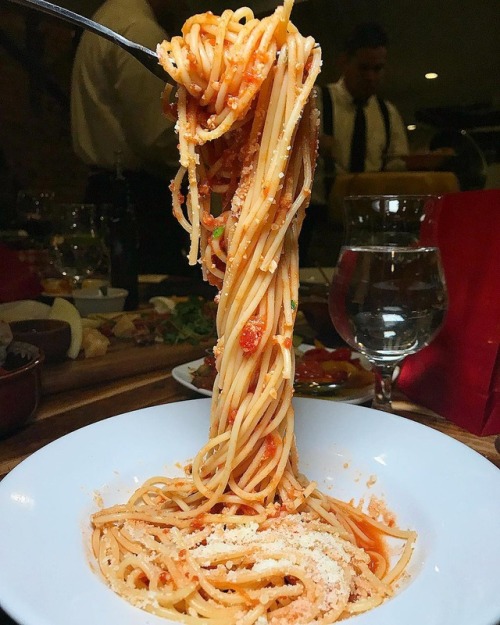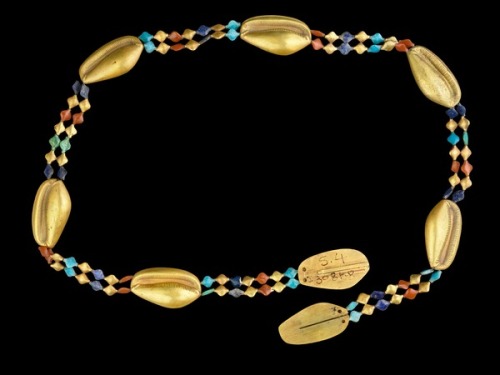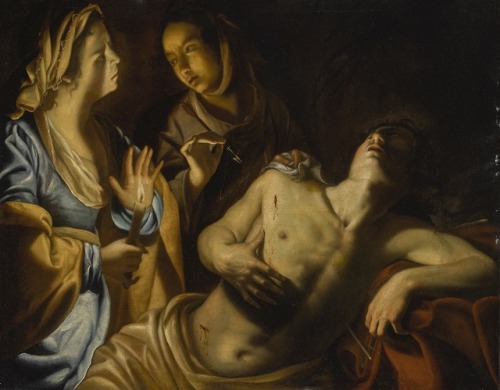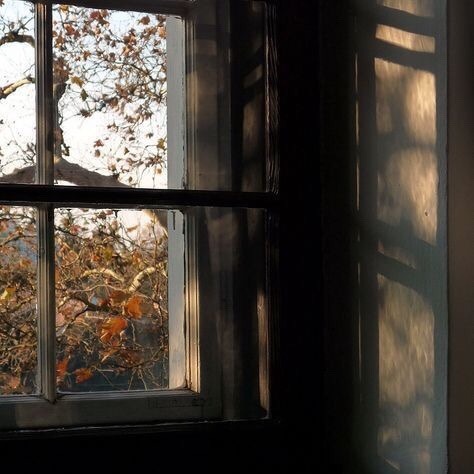Teddyglez1976 - Rincón De Sibaritas

More Posts from Teddyglez1976 and Others

It’s spooky time!


Girdle of Princess Sithathor
This girdle of the Princess Sithathor is made of eight gold, half-open cowry shells. The ones at each end have flat reverses, and were joined by means of grooves to serve as a clasp, fastening the girdle when they slid one into the other. The shells are separated from each other by rhomboidal polychrome beads of carnelian, feldspar, and lapis lazuli.
Gold cowry shells were imitations of the real cowry shells that had been used in belts, bracelets, anklets, and necklaces since the pre-dynastic period. People thought that cowry shells possessed powerful magical properties and increase female fertility.
Princess Sithathor was a daughter of King Senusret II, and was most probably a sister of Senusret III, as she was buried within his pyramid complex at Dahshur. Very fine pieces of jewelry that belonged to her were found in her tomb; they are now preserved in the Egyptian Museum in Cairo.
Middle Kingdom, 12th Dynasty, reign of Senusret II, ca. 1897-1878 BC. Now in the Egyptian Museum, Cairo. JE 30858
PANDORA Bracelets | REEDS Jewelers
Click here: http://bit.ly/braceletcharms

"Ahora te quiero, como el mar quiere a su agua: desde fuera, por arriba, haciéndose sin parar con ella tormentas, fugas, albergues, descansos, calmas".
Pedro Salinas.

The Education of Love. Paolo de Matteis. Italian 1662-1728. oil/canvas. http://hadrian6.tumblr.com

Artemisia Gentileschi (Italian, 1593 - c. 1656): Saint Sebastian tended by Irene (via Sotheby’s)

Newspaper Reading (1855). Reinhard Sebastian Zimmermann (German, 1815-1893). Oil on canvas.
A young woman reads a newspaper, perhaps to her father and dog, in a nicely appointed interior. The man holds what may be a snuff box. Both man and dog are very attentive to the news being read. Books sit on the desk to the rear.
👑👑👑

The Mummy of Queen Hatshepsut
The Mummy of Hatshepsut was found by Howard Carter in KV60, in the Valley of the Kings. While assembling all unidentified mummies with their right arms placed across their chests a royal posture for the Egyptian Mummy Project, some were studied with a CT-scan machine.
At the same time a canopic box from the Deir el-Bahri cachette that was inscribed for Hatshepsut and contained her liver was also scanned. There was also a tooth inside, a molar with a root; and when examined it was found that it fitted exactly into the mouth of one of the royal women.
After analysis of Hatshepsut’s mummy, it was concluded that she had died at about the age of fifty, that she had been obese, and that she had diabetes and cancer. The box that contained the tooth is also on display near the mummy.
Now in the Egyptian Museum, Cairo.




Angel of autumn and magic
-
 moramofados reblogged this · 2 months ago
moramofados reblogged this · 2 months ago -
 luvclassics liked this · 2 months ago
luvclassics liked this · 2 months ago -
 yzomkehrm liked this · 2 months ago
yzomkehrm liked this · 2 months ago -
 mulberryleaves reblogged this · 2 months ago
mulberryleaves reblogged this · 2 months ago -
 nearina reblogged this · 6 months ago
nearina reblogged this · 6 months ago -
 raquel-lopez liked this · 8 months ago
raquel-lopez liked this · 8 months ago -
 nearina liked this · 9 months ago
nearina liked this · 9 months ago -
 pathologicalpeoplepleaserrps reblogged this · 9 months ago
pathologicalpeoplepleaserrps reblogged this · 9 months ago -
 outtafvcks liked this · 11 months ago
outtafvcks liked this · 11 months ago -
 loveyz liked this · 11 months ago
loveyz liked this · 11 months ago -
 cgj13 liked this · 11 months ago
cgj13 liked this · 11 months ago -
 westcoastgent liked this · 11 months ago
westcoastgent liked this · 11 months ago -
 ursexxxxybeast liked this · 11 months ago
ursexxxxybeast liked this · 11 months ago -
 smallstrawrry liked this · 11 months ago
smallstrawrry liked this · 11 months ago -
 j0sh-bee liked this · 11 months ago
j0sh-bee liked this · 11 months ago -
 ka-heelee reblogged this · 11 months ago
ka-heelee reblogged this · 11 months ago -
 theskanderbeg reblogged this · 11 months ago
theskanderbeg reblogged this · 11 months ago -
 that-texas-belle reblogged this · 11 months ago
that-texas-belle reblogged this · 11 months ago -
 lonewolf9027 liked this · 11 months ago
lonewolf9027 liked this · 11 months ago -
 monnielobo liked this · 11 months ago
monnielobo liked this · 11 months ago -
 kindoflikedondraper reblogged this · 11 months ago
kindoflikedondraper reblogged this · 11 months ago -
 kindoflikedondraper liked this · 11 months ago
kindoflikedondraper liked this · 11 months ago -
 cj7hyper reblogged this · 11 months ago
cj7hyper reblogged this · 11 months ago -
 cj7hyper liked this · 11 months ago
cj7hyper liked this · 11 months ago -
 aintnothinlike-a-georgiagirl reblogged this · 11 months ago
aintnothinlike-a-georgiagirl reblogged this · 11 months ago -
 mayshamrock reblogged this · 11 months ago
mayshamrock reblogged this · 11 months ago -
 mayshamrock liked this · 11 months ago
mayshamrock liked this · 11 months ago -
 dachshundsworld reblogged this · 11 months ago
dachshundsworld reblogged this · 11 months ago -
 franacheck liked this · 11 months ago
franacheck liked this · 11 months ago -
 whitefireprincess reblogged this · 11 months ago
whitefireprincess reblogged this · 11 months ago -
 missrupy liked this · 1 year ago
missrupy liked this · 1 year ago -
 juliadori reblogged this · 1 year ago
juliadori reblogged this · 1 year ago -
 save-my-life-with-a-song-but-gay reblogged this · 1 year ago
save-my-life-with-a-song-but-gay reblogged this · 1 year ago -
 foodieapp reblogged this · 1 year ago
foodieapp reblogged this · 1 year ago -
 moonlight-pisces reblogged this · 1 year ago
moonlight-pisces reblogged this · 1 year ago -
 gensounohana reblogged this · 1 year ago
gensounohana reblogged this · 1 year ago -
 itsumaidemo reblogged this · 1 year ago
itsumaidemo reblogged this · 1 year ago -
 fazedinlights liked this · 1 year ago
fazedinlights liked this · 1 year ago -
 x-miss-chaos-x reblogged this · 1 year ago
x-miss-chaos-x reblogged this · 1 year ago -
 yuralria reblogged this · 1 year ago
yuralria reblogged this · 1 year ago
Dedicado a los finos amantes de las bellas artes y el estilo exquisito del buen comer.
145 posts